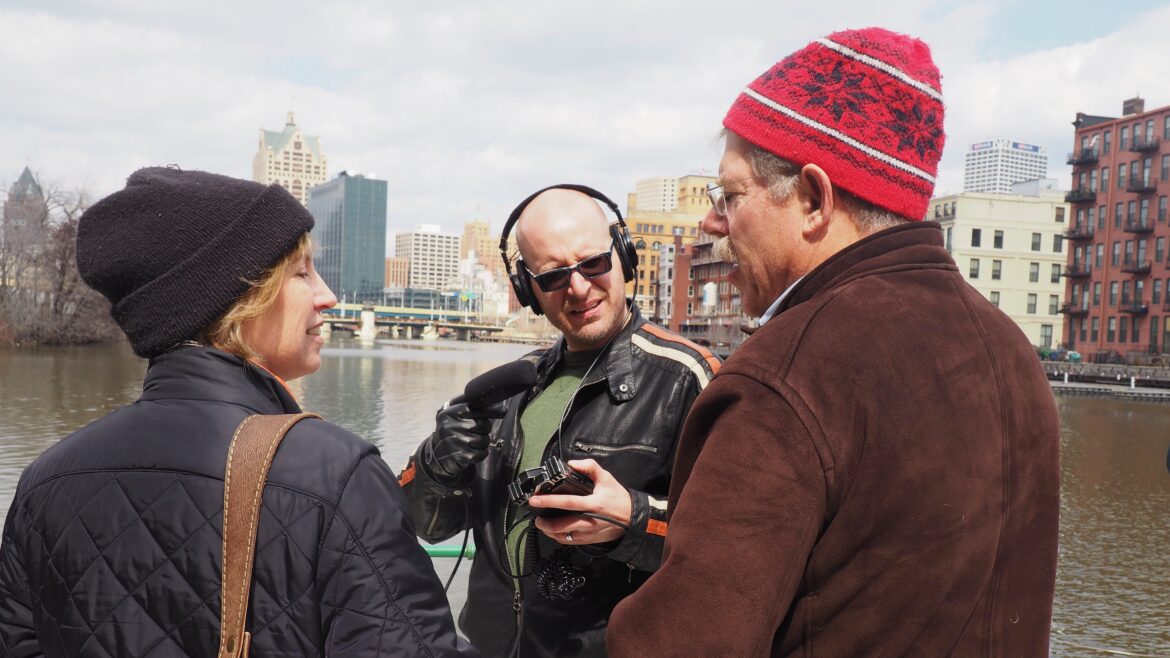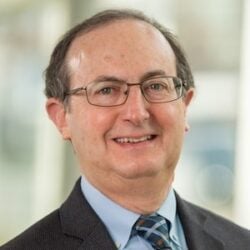Why ‘radical listening’ is key to public radio’s future

Mark Riechers / PBS Wisconsin
Joe Hardtke recording on the Milwaukee River with "To the Best of Our Knowledge" host Anne Strainchamps and historian John Gurda.
It was ostensibly a story about french fries. My program, To the Best of Our Knowledge, was assembling a show on food, nostalgia and identity when I boldly offered that my hometown — Kewaunee, Wisconsin — produced the best fries in drive-in history. My colleagues took the bait, and I headed back to a farming community of 2,800 people and one stoplight, my Roland R-26 and an assortment of microphones in my bag. It’s 30 miles east of Lambeau Field on Lake Michigan, if you’re curious.
While I have years of reporting in my DNA, these days I’m the technical director and sound designer for a nationally distributed radio show about philosophy and intelligent optimism. I’m also an independent musician from rural America who composes with found sounds and ambience. And like everyone in the media, I’m troubled by a country battered and bruised by decades of polarized news and exhausting election cycles. But I believe my particular niche in public broadcasting holds a possible way forward for our industry and our healing: radical listening inspired by the patience of field recording.
The field recordist operates with a different sonic mindset. We seek truth, like our reporter colleagues, but equally prize a strong metaphor. We acutely understand that hard lessons and heartache can be heard on a rainswept empty street or in a reverberant hospital hallway. Words are our currency in radio, but some emotions can only be expressed by carefully extracting them from the supposed silence. And gathering a pure version of that illustrative sound demands a relationship with the subject that goes beyond the interview.
Driving back to my family farm brings a reset that feels natural to the way I hear the world. Cows outnumber humans four to one where I come from, and that does something to a person. Humility mixes with uncelebrated, working-class duty, which can atrophy into resentment. Words become expensive, which plays into my favorite strategy: Having the ears that I do, I spent a considerable amount of time at the setting of my story, just listening. This particular assignment seemed apolitical, involving a former burger joint that hasn’t served a meal in over two decades.
Jumbo’s Drive-In sat abandoned, so I started with a stereo mic attachment, capturing the passing cars on Highway 42. How many of these drivers still remember this hangout during its heyday? The crows seemed to remember. I was on their turf, and they weren’t afraid to tell me. After 30 minutes alone, I was joined by my interview subjects, Susan Sevcik and Adam Kolmorgen, two former employees from two very different eras of the business. I made certain we had enough time for some collective listening.
When I’m in field-recording mode, I like to use my gear to announce my intention. My headphones are on, my AT8035 shotgun mic is pointed away from the people. The questions are few. This tends to subvert the traditional reporter-subject relationship. I became their guest as they pointed out where the kitchen walls used to be, where the local kids would park their bikes. The space between spoken thoughts grew longer as the emotions felt bigger.
Active listening has arguably been around for centuries. It involves verbal and nonverbal engagement to establish comprehension. Personal filters can still be a factor. But radical listening goes a step further, setting aside preconceived notions and giving the speaker ample space to reveal their hopes and fears. This skill is organic to field recording. In fact, I would argue it’s one of our favorite tools. Using our body language and visible curiosity — no judgment — we’re drawing the people around us into a shared listening experience, celebrating the impact of location on our subjects’ lives. That comes with relinquishing the power of media and — when done carefully — a transfer of ownership of the story. I am earning the respect of my recording partners, which is often rewarded.
Of course, none of this was spoken. Susan and Adam seemed to understand the feelings I was collecting, and we began to search for them together. The worn gravel path around the back door hinted at the hundreds of teenagers who had taken the garbage out since the ’60s. We rattled the locks of an empty building that no longer welcomed us. We waved at the corporate dairy trucks speeding past the property, their family farm ancestors once the lifeblood of this community.
Too often, the story is told already and then reinforced with questions and answers. I understand that. What if you let the story tell itself? We are not all trained to write and express ourselves, except to get through high school. Why does news need to be that way?
Susan Sevcik, retired schoolteacher
The field recording complete, we moved to a nearby park where the subsequent interview felt especially unguarded. I switched my shotgun mic for two Shure SM87As as my equipment and posture suggested a slight change in roles, but the location was still theirs. We sat at an old green bench that had likely been there since Adam’s childhood. Yes, we discussed the fries, but there was no list of questions, and radical listening led the way. Susan and Adam quickly moved to the plight of family restaurants in their small town. They expressed concern over what factory agribusiness had done to the community. But the most meaningful moment, I believe, was guided by our newly established trust.
I had known Susan’s sister Patti had been struck by a car and killed while riding her bike to Jumbo’s. It was a topic I would broach with care and timing, but Susan was more than ready. She recalled the weather, the police cars and swapping shifts with her sister that day. And I remember Adam’s body language, creating the space for Susan to lead. Everyone’s listening was heightened and passionate. Silence never felt awkward, and I barely remember the questions asked. This was a space for sharing. I was given temporary care of Susan’s story, and radical listening made her ownership and boundaries clear.
This was not my first Kewaunee story, and it likely won’t be my last. I recorded the world’s largest grandfather clock with the town’s former mayor for one memorable feature. I also reminisced with former employees of the town’s old radio station, which played polka music sunrise to sunset. The station no longer exists. There is no daily newspaper and a noticeable distrust of reporters in general. My hometown is deeply red, voting Republican almost 75% of the time. But none of that was apparent at Jumbo’s. And maybe that’s a sign.
You were genuinely curious about the subject, the history, the symbol [and] meaning to the community.
Jason Jelinek, former mayor of Kewaunee
I understand that public radio reporters would love the luxury of covering local french fries and recording old clocks for a half hour. These are human interest pieces built for long-form programming, not necessarily for local news windows on All Things Considered. But as a practice, I don’t think it’s something we can afford to look past. Listeners crave local content in nearly every measurable way. Building radical listening and field recording into our program offerings announces to the audience that we understand our public service role as custodians of culture and media representation. It’s not simply content; it’s a relationship that will reward future programming, marketing and fundraising efforts.
So where do we start? It could be as small as sonic IDs between programs. It could be as large as regular features in a weekly program. But the real work, to my ears, is using this strategy as a foundation stone for our shared recording culture. This doesn’t require the latest handheld recording gear — it requires better training on the gear you already have, including the smartphone in your pocket. It demands editors who put a priority on location sound and work with teams to set objectives. Imagine a generation of public radio reporters and producers who use the collection of local audio as a part of their outreach, forming stronger bonds while reflecting the sound of their communities. Now imagine an audience that respects our service over partisan media because of our reputation for quality listening and work with the public.
To be clear, do I believe reporters should bury questions about disingenuous or harmful opinions in our current divide in the hopes of finding some sonic Shangri-la? Absolutely not. A small atoll of pleasant audio is not worth a swim in a toxic ocean. But if the community participates in good faith, there may be a place for an approach inspired by our friends, the field recordists. An approach guided by patience and not pressure. Listening and not lists of questions. It takes time, training and vision, but that shared celebration of sacred spaces may help heal America from the farm fields to the cities. And public broadcasters, with our mission and history, are in a unique position to show journalism how it’s done.
Joe Hardtke is technical director and sound designer of To the Best of Our Knowledge, produced at Wisconsin Public Radio and distributed by PRX. He’s a 30-year broadcasting veteran, independent musician and sound artist. His award-winning ambient work has been heard on WBEZ, BBC Radio 4, at the Third Coast International Audio Festival and sound installations around the world. And, yes, his first radio gig was at that polka station.







